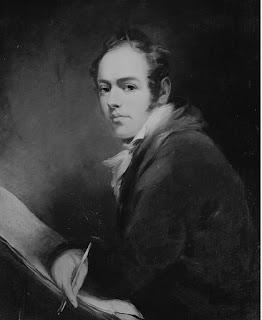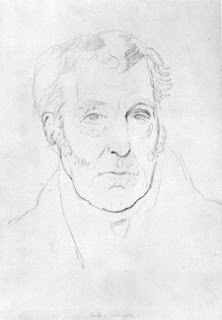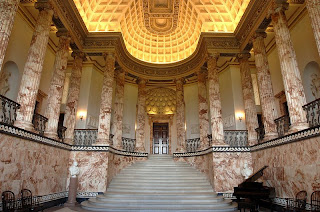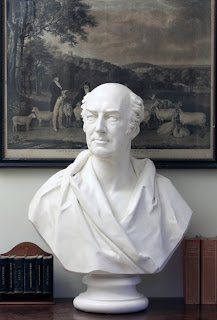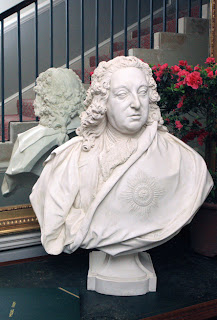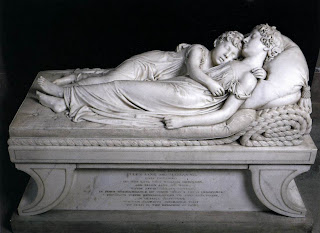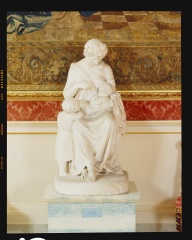by Victoria Hinshaw
For those of us who love to poke around in British palaces, castles, stately homes, museums and all sorts of historical sites (that’s probably all of us), with a special interest in the Georgian and Victorian periods (most of us??), sooner or later we will begin to notice the recurring name of Francis Chantrey, a sculptor whose works are simply all over the place.
Sir Francis Legatt Chantrey (1781-1841) was not only a renowned and prolific artist, but also a philanthropist who left a bequest for the purchase of artwork for the nation. The income from investing the £105,000 from his legacy has been used to purchase hundreds of artworks by British artists for the nation’s museums and continues to this day.
Drawings Chantrey made of Sir John Soane, preparatory work for the bust Chantrey sculpted which today can be seen in Sir John Soane’s Museum, Lincoln’s Inn Fields, London, below.
Below, a sketch of the pedestal made by Chantrey for the Wellington statue.
Above, the Marble Hall at Holkham Hall in Norfolk, the estate of the earls of Leicester. On either side of the staircase (on the right behind the piano) are two busts by Sir Francis Legatt Chantrey.
Reproduction of a marble bust of Coke of Norfolk (1754-1842), by Chantrey, from 1829, which can be purchased from the estate at their website: http://www.holkhamsculpturereproductions.co.uk/
Coke of Norfolk, a great agricultural innovator, was the great nephew of Thomas Coke, and Coke of Norfolk was named 1st Earl of Leicester of the Seventh Creation in 1837.
Below, the reproduction of Chantrey’s marble copy of a bust of Thomas Coke, first Earl of Leicester (1697-1759) of the Sixth Creation. created by Louis Francoise Roubilliac (1705-1762). Both busts were sculpted to stand among the large collection of classical busts acquired by Thomas Coke and displayed at Holkham.
Above, Sir Joseph Banks in the British Museum, Botanist, Trustee and Benefactor, by Sir Francis Chantey, dated 1826.
Besides the dozens of busts Chantrey sculpted, which were highly prized and sought after, he did some touching works which displayed his skill in composition as well as compassion.
The Sleeping Children, 1817, above, in the Litchfield Cathedral, was commissioned by the widowed mother of the two dead girls, Mrs. Ellen-Jane Woodhouse Robinson. Most observers find it the finest of Chantrey’s works.
The lovely portrayal of Dorothea Jordan was commissioned from Chantrey by King William IV and completed in 1834. It has been displayed in Buckingham Palace since 1980. Mrs. Jordan, a leading actress of her day, was the long-time mistress of William IV when he was Duke of Clarence and bore him ten children, known by the surname FitzClarence.
This drawing of the anteroom of Chantrey’s sculpture gallery (30 Belgrave Place) shows its design by Sir John Soane for his friend, the sculptor.
This charming portrait of Mustard, Chantrey’s terrier, and his sculpting tools was presented to Queen Victoria by Lady Chantrey in 1842. According to the description in the Royal Collection, “The painting was commissioned in April 1835 by Chantrey, who sent Landseer a humorous letter, supposedly from Mustard. It was exhibited at the Royal Academy in 1836 when it was admired by Queen Victoria.” After Chantrey’s death, his widow presented the painting to the Queen.
Also in the Royal Collection is this watercolour on ivory by Andrew Robertson (1777-1845), dated 1800. Purchased by Queen Victoria in 1880, it portrays Chantrey “Half-length, standing, facing slightly to the right, wearing a grey studio coat and dark blue waistcoat and holding a hammer, chisel and yellow dustcloth, beside his bust of George IV; grey-blue eyes, grey-brown hair; red curtains background.”
The painting above is The Burial of Sir Frances Chantrey by artist Henry Perlee Parker, 1841. It was badly damaged in a flood in 2007 at the Weston Park Museum, Sheffield, and had to be dried for more than a year before it was conserved. Chantrey is buried in St. James Church, Sheffield, near the village of his birth.

